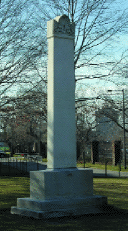 |
| "Your wooden arm you hold outstretched to shake with passers-by." |
The athletic fields of Harvard lie near the Charles River in Allston on land called "The Soldiers Field." "Few people know the Civil War significance of the name," writes Helen Hannon in Blue & Gray Magazine.
Professor and poet Henry Wadsworth Longfellow, LL.D. 1859, gazed on these meadowlands from his house on Brattle Street in Cambridge, Hannon relates. In 1870 he and others gave 70 acres of them to Harvard. Major Henry Lee Higginson, LL.D. '82, a member of the class of 1855, received a sabre cut across his face and a pistol bullet at the base of his spine in the Battle of Aldie, Virginia, in 1863, but he survived and prospered. In 1890 he gave Harvard a further 31 acres of Allston land with the hope that they would become playing fields. He wished that the grounds be called "The Soldiers Field" and be "marked with a stone bearing the names of some dear friendsalumni of the University, and noble gentlemen."
Hannon leads readers just inside the gate into the athletic complex nearest the An  |
| The Soldiers Field Monument |

Tablets in Memorial Hall name 136 alumni who died fighting for the North. Sixty-nine (perhaps 71) alumni died for the Confederate cause, says Helen P. Trimpi, Ph.D. '66. An independent scholar and poet who lives in Palo Alto, Trimpi is seeking a publisher for her soon-to-be-completed biographical register of approximately 470 alumni, a manuscript she calls "Crimson Confederates: Harvard Men Who Fought for the South." A proposal to memorialize all alumni who died in the war on tablets in Memorial Church was approved by an ad hoc committee of the Harvard Alumni Association in 1995 ("Both Sides Now?" January-February 1996, page 69). The Overseers considered the proposal, and objections to it from the Associated African-American Harvard Alumni and others, and it was tabled.

Expanding on alma mater's Confederate connections, Barbara Long, Ph.D. '82, M.D., an Atlanta psychiatrist, points out that General Robert E. Lee's second son, William Henry Fitzhugh "Rooney" Lee, was a Harvard man, class of 1858. A cavalryman, he became the youngest major general in Confederate service and went on to duty in the U.S. House. But Harvard did him in, if one believes classmate Henry Adams in The Education of Henry Adams.
 |
| Lee |
| Harvard University Archives |
Mary Daughtry, author of a biography of Lee forthcoming from Da Capo Press, challenges Adams. "Lee left Harvard before graduating because he fell in love," she says. "He wanted to make a living so that he could marry." So he did, in 1859.
Lee maintained connections with his Harvard friends and attended his class's thirtieth-reunion dinner in Cambridge.
Lee was a skilled oarsman and in 1857 was president of Oneida, a Harvard rowing club. On June 13, he was part of the University crew that rowed against the Union Boat Club on the Charles. Lee family lore has it that it was Rooney and his mates who wore distinguishing red bandannas, thus leading to the establishment of crimson as Harvard's color. "That is the hearsay that I have always known of," Robert E. Lee IV, Rooney's grandson, says today. President Charles W. Eliot '53, years after the event, remembered that he and Benjamin W. Crowninshield '58 bought red bandannas for the crew to wear in 1858 ("Crimsonalia," January-February 1997, page 74), and evidence supports him. Perhaps Eliot and Crowninshield institutionalized a fashion tested earlier.
~Primus V





